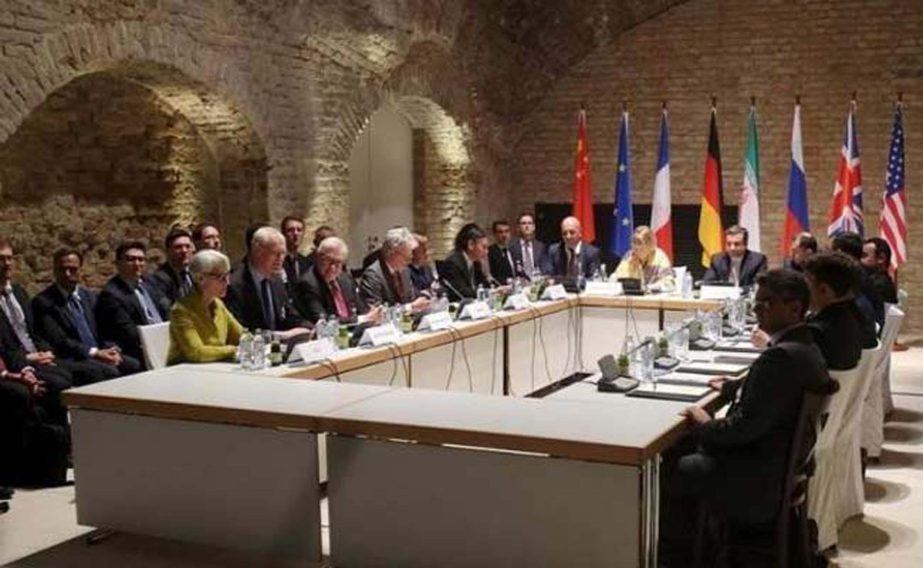
AFP, Vienna :
Iran is complying so far with the July 2015 landmark nuclear deal with major powers, a report from the UN atomic watchdog seen by AFP showed on Friday.
The International Atomic Energy Agency’s first assessment since the accord came into force on January 16 showed that Iran was meeting its main commitments.
As agreed, Iran “has not pursued the construction of the existing Arak heavy water research reactor” and has “not enriched uranium” above low levels, the IAEA report said.
Iran’s stockpile of low-enriched uranium, material which can be used for peaceful purposes but when further processed for a nuclear weapon, has not risen about the agreed level of 300 kilos (660 pounds).
The Vienna-based IAEA added that “all stored centrifuges and associated infrastructure have remained in storage under continuous Agency monitoring” and no enriched uranium has been accumulated through research and development activities.
The steps taken by Iran under the 2015 deal extend to at least a year, up from a few months before the accord, the length of time Tehran would need to make one nuclear bomb’s worth of fissile material.
They included slashing by two-thirds its uranium centrifuges, slashing its stockpile of uranium — several tonnes before the deal, enough for several bombs — and removing the core of the Arak reactor which could have given Iran weapons-grade plutonium.
Centrifuges are machines that “enrich” uranium by increasing the proportion of a fissile isotope, rendering it suitable for other purposes.
Throughout the 12-year standoff that preceded the deal, Iran always denied wanting nuclear weapons, saying its activities are exclusively for peaceful purposes such as power generation.
In return for the scaling down of its nuclear activities, painful UN and Western sanctions were lifted on the Islamic republic, including on its lifeblood oil exports.
The IAEA report did also say however that Iran briefly went above the agreed need of 130 tonnes of “heavy water” for the Arak reactor by 900 kilos since the deal came into force.
But the level of this material has since fallen back down below 130 tonnes, and this was not expected to be seen as a major violation of the 2015 agreement.
Iran is complying so far with the July 2015 landmark nuclear deal with major powers, a report from the UN atomic watchdog seen by AFP showed on Friday.
The International Atomic Energy Agency’s first assessment since the accord came into force on January 16 showed that Iran was meeting its main commitments.
As agreed, Iran “has not pursued the construction of the existing Arak heavy water research reactor” and has “not enriched uranium” above low levels, the IAEA report said.
Iran’s stockpile of low-enriched uranium, material which can be used for peaceful purposes but when further processed for a nuclear weapon, has not risen about the agreed level of 300 kilos (660 pounds).
The Vienna-based IAEA added that “all stored centrifuges and associated infrastructure have remained in storage under continuous Agency monitoring” and no enriched uranium has been accumulated through research and development activities.
The steps taken by Iran under the 2015 deal extend to at least a year, up from a few months before the accord, the length of time Tehran would need to make one nuclear bomb’s worth of fissile material.
They included slashing by two-thirds its uranium centrifuges, slashing its stockpile of uranium — several tonnes before the deal, enough for several bombs — and removing the core of the Arak reactor which could have given Iran weapons-grade plutonium.
Centrifuges are machines that “enrich” uranium by increasing the proportion of a fissile isotope, rendering it suitable for other purposes.
Throughout the 12-year standoff that preceded the deal, Iran always denied wanting nuclear weapons, saying its activities are exclusively for peaceful purposes such as power generation.
In return for the scaling down of its nuclear activities, painful UN and Western sanctions were lifted on the Islamic republic, including on its lifeblood oil exports.
The IAEA report did also say however that Iran briefly went above the agreed need of 130 tonnes of “heavy water” for the Arak reactor by 900 kilos since the deal came into force.
But the level of this material has since fallen back down below 130 tonnes, and this was not expected to be seen as a major violation of the 2015 agreement.

